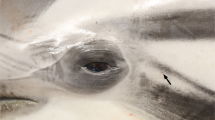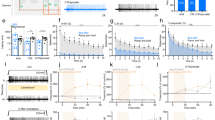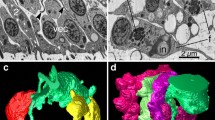Abstract
METHYLENE blue, injected subcutaneously, will stain particular elongated cells, spindle-shaped or flask-shaped, in the epidermis of various teleost fish. Such cells were found by Whitear1 in the minnow (Phoxinus laevis), and afterwards in several other species, both freshwater and marine; that paper should be consulted for references to the scanty earlier literature on the subject. It was suggested that these cells are receptors for the common chemical sense, but as it seems preferable to describe them by a term not indicative of a supposed function, they will be called ‘spindle cells’ here. For technical reasons, the exact relationship of the spindle cells to the surface of the skin, and to nerve fibres, could not be ascertained by means of the light microscope.
This is a preview of subscription content, access via your institution
Access options
Subscribe to this journal
Receive 51 print issues and online access
$199.00 per year
only $3.90 per issue
Buy this article
- Purchase on Springer Link
- Instant access to full article PDF
Prices may be subject to local taxes which are calculated during checkout
Similar content being viewed by others
References
Whitear, M., Quart. J. Micros. Sci., 93, 289 (1952).
Farquhar, M. G., and Palade, G. E., J. Cell. Biol., 17, 375 (1963).
Trujillo-Cenóz, O., Z. Zellforsch. mikrosk. Anat., 54, 654 (1961).
Author information
Authors and Affiliations
Rights and permissions
About this article
Cite this article
WHITEAR, M. Presumed Sensory Cells in Fish Epidermis. Nature 208, 703–704 (1965). https://doi.org/10.1038/208703b0
Issue Date:
DOI: https://doi.org/10.1038/208703b0
This article is cited by
-
Olfactory and solitary chemosensory cells: two different chemosensory systems in the nasal cavity of the American alligator, Alligator mississippiensis
BMC Neuroscience (2007)
-
Ecomorphology of solitary chemosensory cell systems in fish: a review
Environmental Biology of Fishes (1995)
-
Fine structure of the epidermis of the mudskipper,Periophthalmus modestus (Gobiidae)
Japanese Journal of Ichthyology (1992)
-
Quantitative scanning electron microscopy of solitary chemoreceptor cells in cyprinids and other teleosts
Environmental Biology of Fishes (1992)
-
Solitary chemosensory cells ? taste, common chemical sense or what?
Reviews in Fish Biology and Fisheries (1991)
Comments
By submitting a comment you agree to abide by our Terms and Community Guidelines. If you find something abusive or that does not comply with our terms or guidelines please flag it as inappropriate.



